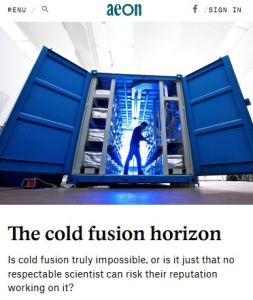Únase a getAbstract para acceder al resumen.

Únase a getAbstract para acceder al resumen.
Huw Price
The Cold Fusion Horizon
Aeon, 2016
¿De qué se trata?
What if the solution to the energy crisis were within reach, but mainstream scientists are ignoring it?
Recommendation
University of Cambridge philosophy professor Huw Price puts a human face on the scientific community’s skepticism towards cold fusion, saying it really stems from scientists’ fear of falling into a “reputation trap.” Few “real scientists” are willing to risk looking like they are dabbling in “pseudoscience.” With a conversational tone, Price keeps the science and the sociology simple. He doesn’t try to convince his readers that cold fusion works, only that they should all invest in finding out whether it does. getAbstract recommends Price’s thesis to everyone interested in the future of energy production.
Summary
About the Author
University of Cambridge philosophy professor Huw Price, PhD, is also academic director of the Center for the Study of Existential Risk and the Leverhulme Centre for the Future of Intelligence.


















Comment on this summary